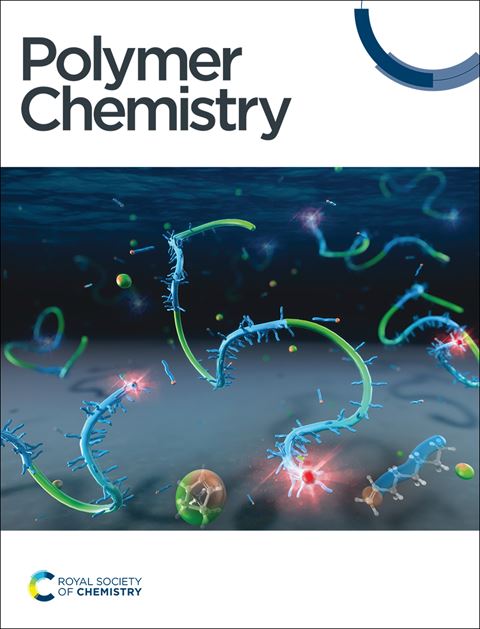Fluorescent surface-grafted block copolymer brushes obtained in a versatile post-polymerization approach†
IF 4.1
2区 化学
Q2 POLYMER SCIENCE
引用次数: 0
Abstract
Surface-grafted luminescent polymer brushes are promising materials for applications in sensing, stimuli-responsive and light-harvesting systems. We report the synthesis of photoactive block copolymer brushes through surface-initiated atom transfer radical polymerization followed by post-polymerization functionalization and chain extension. The attachment of the bulky fluorophore, 6-aminofluorescein (6AF), to poly(glycidyl methacrylate) (poly(GMA)) brushes grafted from ITO-coated substrates was optimized by changing the solvent from DMSO to nitromethane and adjusting the amine catalyst from triethylamine to pentamethyldiethylenetriamine (PMDETA). This resulted in a faster, more controlled coupling of 6AF, leading to homogeneous distribution of chromophores within the brushes. Despite the aggregation-caused quenching nature of fluorescein, high concentrations of 6AF maintained efficient fluorescence, attributed to covalent attachment to polymer chains adopting extended conformations. Importantly, reducing PMDETA concentration preserved chain end activity, enabling the formation of apoly(GMA) block copolymer brush. The successful synthesis of block copolymers was confirmed by AFM and FTIR analyses. UV-Vis and fluorescence spectroscopy revealed that the formation of the second poly(GMA) block did not affect the photophysical properties of the first block. These photoactive block copolymer brushes, with densely packed, non-aggregated fluorophores, offer potential for light energy transfer applications and facilitate the fabrication of multi-block polymer systems with bulky pendant groups.

求助全文
约1分钟内获得全文
求助全文
来源期刊

Polymer Chemistry
POLYMER SCIENCE-
CiteScore
8.60
自引率
8.70%
发文量
535
审稿时长
1.7 months
期刊介绍:
Polymer Chemistry welcomes submissions in all areas of polymer science that have a strong focus on macromolecular chemistry. Manuscripts may cover a broad range of fields, yet no direct application focus is required.
 求助内容:
求助内容: 应助结果提醒方式:
应助结果提醒方式:


